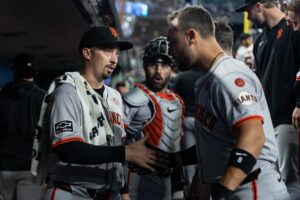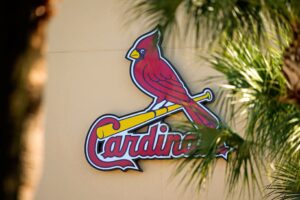Archie Bradley Has Become a Top Closer
(Author’s Note: This article uses the Goose Egg statistic. Nate Silver invented the statistic for clutch late-inning performance, explaining it here.)
In June of 2019, Arizona Diamondbacks reliever Archie Bradley was in one of the toughest stretches of his career. He had pitched well in 2017, posting a 1.73 ERA (38 ERA-) as a set-up man for Fernando Rodney. During the Wild Card Game against the Colorado Rockies, he made up for a so-so pitching outing by cracking a crucial two-run triple, the only postseason triple ever hit by a reliever. He battled a split fingernail on his right index finger in 2018, a devastating injury for a pitcher whose top off-speed pitch is a knucklecurve. He started well in 2019, posting a 1.93 ERA (44 ERA-) as a set-up man for Greg Holland in the first six weeks of the season.
Then May hit.
The six weeks from May 4 to June 22 were a nightmare for Bradley as he gave up 19 earned runs in 21 innings for an 8.14 ERA (185 ERA-). He also gave up 28 hits and 14 walks – a 2.000 WHIP. His command had gone out the window, and his confidence was fading fast. “Not that I was the worst pitcher ever, but I was pretty bad,” Bradley told reporters in August of 2019. “I really did not have any clue where the ball was going.”
He turned it around over the next month. From June 26 to July 26, he dazzled, allowing six hits and six walks over 11 innings for a 1.091 WHIP. Most importantly, his ERA was 0.00. This became even more important when Holland fell apart and lost his job.
Archie Bradley Becomes the Closer – and a Darn Good One
Although manager Torey Lovullo did not officially give Bradley the title of “closer” until much later, Bradley took over as the go-to guy in late innings on July 30 in Yankee Stadium. He pitched 1 1/3 perfect innings to close out a 4-2 victory and earn a save.
During his slump, he worked with the coaches, catchers, and analytics expert on his mechanics, sequencing, and location. This included Lovullo, bullpen coach Mike Fetters, then-pitching coach Mike Butcher, then-catcher Alex Avila, catcher Carson Kelly, and analytics head Mike Fitzgerald. He credited all of them with helping him both get back into form and regain his confidence.
Since then, he has been magnificent. He has pitched 33 games, finishing 31 of them. In 34 2/3 innings, he has converted 24 of 26 save opportunities (92%). His Goose Egg statistics were just as, if not even more, impressive, as he notched 21 Goose Eggs (GE) to go against one Broken Egg (BE) and six Mehs (M). The historical average ratio (back to 1921) of GE to BE is 3-to-1. Bradley’s ratio is 21-to-1. In addition, he has a solid 1.154 WHIP, a 2.60 ERA (58 ERA-), 7.27 hits per nine (H/9), 0.52 homers per nine (HR/9), 3.12 walks per nine (BB/9), 8.83 strikeouts per nine (K/9), and 2.34 extra-base hits per nine (XBH/9).
Comparing Bradley to the League’s Best
These numbers are all good and well, but numbers mean little without context, so let’s compare them to the top closers in the game. For this study, we’ll use the stats from July 30, 2019 to the present for six of the best closers in the majors: Aroldis Chapman of the New York Yankees, Josh Hader of the Milwaukee Brewers, Liam Hendriks of the Oakland Athletics, Raisel Iglesias of the Cincinnati Reds, Kenley Jansen of the Los Angeles Dodgers, and Mark Melancon of the Atlanta Braves.
(Author’s Note: Don’t “Where’s (name of closer not on the list)?” me. I’m not playing that game. These are the six I picked, and I picked them because they have been toward the top on all of the leaderboards for closers over this span. Moving on.)
Bradley compares favorably to these six – a group that, along with Bradley, we’ll call the Magnificent Seven in deference to the classic film. He is third in save percentage behind Chapman and Melancon, both of whom have converted every save opportunity to finish in a first-place tie. His GE% is toward the bottom, but that is saved by his BE%, which is second to Chapman, who has zero BE.
The next few are interesting. Bradley’s WHIP, H/9, BB/9, K/9, and opponent batting average are all towards the bottom – seventh, sixth, fifth, seventh, and sixth, respectively. Yet this has not hurt him – his ERA- is third, trailing only Chapman (24 ERA-) and Hendriks (48 ERA-). Why is this?
The Reason for the Success of Archie Bradley
The naysayers will say, “See! I told you! He’s just been lucky!” Well, no he hasn’t. Bradley pitches in such a way that batters rarely hit the ball with good contact. Many of the balls put in play are on the ground. Consequently, Bradley has the second-lowest HR/9 of the Magnificent Seven, trailing only Melancon. He also has the third lowest XBH/9 behind Chapman and Melancon.
Keeping the ball in the ballpark is big and keeping it out of gaps in the outfield is even bigger. This means that the hits he gives up are singles, by and large. That makes the next stat even more important, and this is one of the biggest keys to his success – grounding into double plays (GDP). Bradley has induced six double-play grounders – as many as the other six combined. Furthermore, his GDP is three times as high as the second-place finisher, and his rate of GDP per nine is almost three times as high (1.56 to 0.63).
Historical Comparison
Closers do not need to be flame-throwing strikeout artists to be good, although most present-day closers fit the mold. Melancon is not in that mold, and he’s been among the league’s best for several years now. Hall of Famer Mariano Rivera – widely considered to be the best closer in MLB history – was known for throwing a cutter so devastating that batters rarely made solid contact.
Bradley’s bread-and-butter is weak contact and ground balls, just like another Hall of Fame closer – Rollie Fingers. Fingers had a heavy sinker that induced many groundball outs. He was another one who kept the ball in the ballpark and kept it out of gaps. He did not strike many out, either, but he induced a lot of double plays. In fact, their career numbers in rate stats are quite similar, with the exception of GDP/9.
One of the Top Closers in the Game
Archie Bradley is quickly becoming one of the top closers in the game. So far in 2020, it has translated to a tie with Jansen for the National League lead in saves (six). The fact that he does so without blowing hitters away with a blazing fastball makes him sneak under the radar. However, the fact that he gives up few home runs and extra-base hits, coupled with his ability to produce groundball double plays, makes him very difficult to beat in the final innings.
Lovullo could not say enough good things about Archie in a press conference on August 17. “Archie is extremely reliable and in a good spot right now. He always has a very good headspace because he looks at himself realistically and never gets in his own way. I love my conversations with Archie – I’ve loved him since Day One. He’s been extremely honest with me, and, in turn, he’s very honest with himself, (knowing) exactly who he is and what he wants to get to. The success that he’s having right now does not surprise me. He has been good and ready for this challenge.”
The fact that Bradley did this after reaching such a low point in 2019 has impressed many, and Lovullo is among them. “Let’s remember what he walked through. He walked through some really difficult times where there was probably some self-doubt about being able to execute a game plan. But he righted himself because of those reasons that I told you – him realistically looking at things. He is on a full charge right now to be as good as he possibly can, and he’s having great results.”
Outlook
For a Diamondbacks team that has suddenly caught fire, this will give them another great weapon to use going forward. After starting 3-8, they have gone 9-3 and are leading the National League Wild Card standings. His play will be key down the stretch, and although Lovullo isn’t surprised by his success, he also knows that if Bradley hits another lull, he’ll work his tail off to get out of it. “This is exactly who we (the coaching staff) thought he would be, and we felt like if he wasn’t, he was going to work extremely hard to figure out why he wasn’t and be able to go out and execute that plan.” What an inspiration to the rest of the team.
All statistics were compiled by the author from Baseball Reference and Fangraphs. They run up to and including games from August 16, 2020.
Main Photo
Embed from Getty Images






